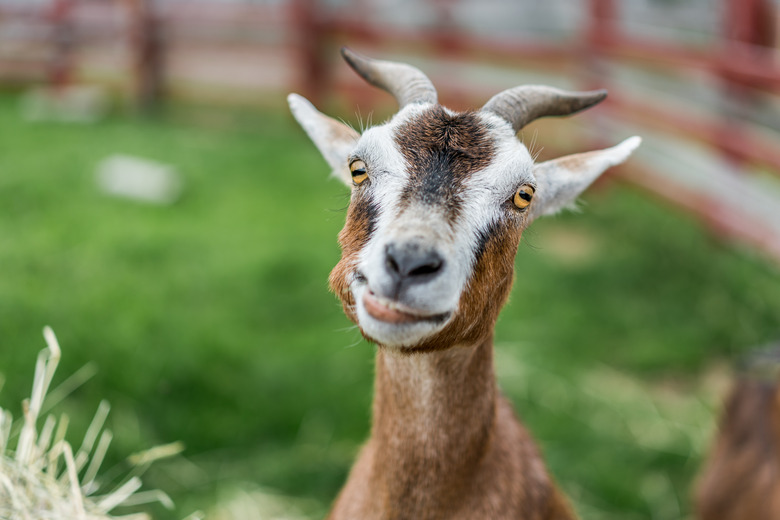Similarities Of Goats & Sheep
Sheep and goats are closely related. Both are in the same subfamily, Caprinae, and it is sometimes difficult to tell if a specific breed or strain is a goat or a sheep. Both goats and sheep are hoofed mammals, or ungulates. Goats and sheep will sometimes mate, although their offspring are typically not fertile. Hybrids between sheep and goats have been produced in laboratories and are termed chimeras.
Ruminants
Ruminants
Sheep and goats are both ruminants. These animals possess a four-chambered stomach in which their food is digested, regurgitated and re-digested. In sheep and goats, the rumen takes up a large portion of the abdominal cavity. It holds food that is consumed quickly, only to be regurgitated at a later stage. This regurgitated food is then re-chewed and swallowed once again in a process termed cud-chewing or ruminating. The process of cud-chewing occurs once the sheep or goat is resting. The rumen functions as a large fermenting receptacle and contains bacteria and other micro-organisms that digest the animal's fibrous meals.
Domestication
Domestication
Both goats and sheep were domesticated about 10,000 years ago. These animals were sought for the products they provided, and by controlling their wandering, early farmers were more easily able to access the animals. Both sheep and goats were considered multi-purpose animals, as they provided not only flesh and milk but dung for fires, skins and fiber or wool. Sheep and goats were initially encouraged to remain close to watering holes, but Neolithic farmers soon began to confine their animals on a more permanent basis.
Reproduction
Reproduction
Sheep and goats have a similar gestation period. Both are pregnant for approximately five months, with sheep carrying for 146 days and goats for 150 days. Both sheep and goats can produce more than one offspring per pregnancy. The estrous cycle is similar in both species, as is the timing of ovulation. With regard to reproduction in general, there is more variation between the various strains of sheep and goats than there is between the two species.
Social Behavior
Goats and sheep are social animals and the ancestors of both lived in moderate sized groups, which helped to protect them against predators and assisted individual animals in finding mates. These groups help both goats and sheep care for and protect the young animals. Both sheep and goats also form matrifocal groups, in which the female animals and their dependant young remain together while the male animals segregate in a smaller band that remains in close proximity to the females. Female goats and sheep both form close bonds with their young.
References
- Sheep 101: Separating the Sheep from the Goats
- Animal Corner: Goats
- FAO: Recent Developments in Reproductive Techniques; H.W. Vivanco
- Sheep101: Let's ruminate on it
- Veterinary Partner; Sheep and Goat Reproduction; Dr. Bob Judd; 2005
- Goatworld; Reproductive Management of the Meat Goat; Stephan Wildeus
Cite This Article
MLA
Bolton, Naomi. "Similarities Of Goats & Sheep" sciencing.com, https://www.sciencing.com/similarities-goats-sheep-8441907/. 22 November 2019.
APA
Bolton, Naomi. (2019, November 22). Similarities Of Goats & Sheep. sciencing.com. Retrieved from https://www.sciencing.com/similarities-goats-sheep-8441907/
Chicago
Bolton, Naomi. Similarities Of Goats & Sheep last modified March 24, 2022. https://www.sciencing.com/similarities-goats-sheep-8441907/
